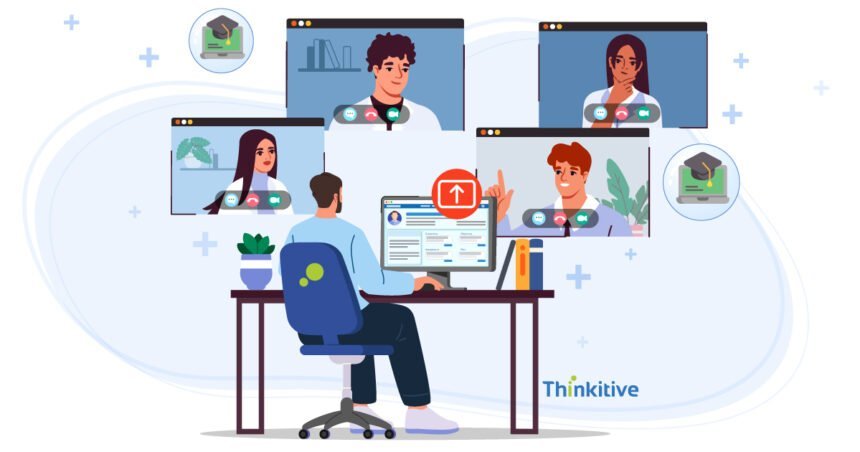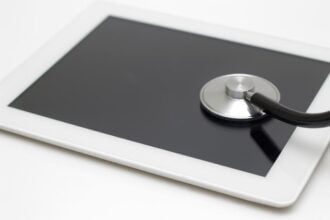We have talked about many of the new types of technology that are changing the healthcare sector. One of the many forms of technology that are playing a role is EHR.
The healthcare landscape is witnessing a surge in adopting custom Electronic Health Record (EHR) solutions. A recent HIMSS Analytics report (2023) indicates a 25% increase in healthcare facilities opting for custom EHRs compared to 2022. This trend is driven by the desire to improve workflow efficiency, streamline data management, and enhance patient care.
However, training and adoption are the only ways to realize a custom EHR’s true potential. Studies have shown that inadequate training can lead to significant drawbacks. A 2023 Journal of the American Medical Informatics Association (JAMIA) study found that poor EHR usability, often a result of insufficient training, can contribute to clinician staff burnout and hinder adoption rates by up to 30%.
This is where a well-designed user training program becomes crucial. It could be very helpful in preventing burnout in the healthcare profession. By equipping staff with the necessary skills and knowledge to navigate the custom EHR effectively, healthcare facilities can maximize the benefits of their investment, fostering improved patient care, increased productivity, and a more positive user experience.
So, let’s delve into the strategies for successful EHR user training and adoption.
- Building a Strong Training Foundation
- Needs Assessment and Targeted Training
Before embarking on any training endeavor, conducting a meticulous needs assessment is crucial. This process involves delving into the intricacies of your organization, identifying various user roles, discerning their existing skill levels, and pinpointing specific training requirements.
By understanding the unique needs of each user group, you can tailor your training programs accordingly, ensuring relevance and efficacy. You can also learn more about EHR in our previous article here.
- Variety in Training Methods
Effective training is one of many propositions for the success of your program. Recognizing your users’ diverse learning styles and preferences is imperative to employ a multifaceted approach encompassing various training methods. From traditional classroom sessions and interactive online modules to hands-on, on-the-job training and visually engaging video tutorials, diversity in training modalities ensures accessibility and engagement for all users.
By embracing this eclectic mix of training methods, you cater to your user base’s diverse needs and preferences, fostering a conducive learning environment where individuals can absorb information effectively and apply it seamlessly within their roles.
- User-Friendly Training Materials
The efficacy of any training program hinges significantly on the quality of its supporting materials. When it comes to custom EHR training, clarity, conciseness, and relevance are paramount.
Investing in the custom EHR software development of user-friendly training materials tailored explicitly to the functionalities of your custom EHR system is a strategic imperative.
- Fostering User Engagement and Adoption
The success of implementation doesn’t solely hinge on the technology itself but also on the active engagement and adoption by the users.
Here, we delve into crucial strategies for fostering user engagement and adoption, ensuring the seamless integration of your custom EHR into healthcare workflows.
- Early User Involvement:
Engaging key stakeholders and users from the outset of the custom EHR software development process is paramount. Their insights and feedback are invaluable in shaping the system to align seamlessly with existing workflows and preferences. By involving users early on, you not only gain a deeper understanding of their needs but also cultivate a sense of ownership and investment in the final product.
This collaborative approach fosters a culture of inclusivity, where users feel valued and heard, laying a solid foundation for successful adoption.
- Addressing User Concerns:
Open communication channels are the lifeline of any successful EHR implementation. Creating avenues for users to voice their concerns, ask questions, and seek assistance throughout the training and beyond is imperative. Proactive communication instills confidence and helps preemptively address any apprehensions or challenges users may face.
Whether it’s through dedicated support teams, user forums, or regular feedback sessions, fostering an environment of transparent communication cultivates trust and ensures users feel supported every step of the way.
- Utilization Incentives and Recognition:
Motivation plays a pivotal role in driving user engagement and adoption. Implementing utilization incentives or recognition programs can significantly boost participation and proficiency levels. These initiatives could range from gamified training modules and performance-based rewards to acknowledging and celebrating milestones achieved in EHR utilization.
By incentivizing active participation, organizations encourage users to embrace the new system and reinforce a culture of continuous learning and improvement. Recognizing and rewarding users for their efforts boosts morale and reinforces the importance of EHR utilization in delivering quality patient care.
- Building a Culture of Continuous Learning
- Regular Updates and Refresher Training
Keeping pace with technological advancements and evolving healthcare practices requires a commitment to ongoing training. Regular updates to the EHR system introduce new features, functionalities, and workflows. To maximize the benefits of these updates, organizations must conduct refresher training sessions tailored to address the specific changes. By providing users with timely and relevant training opportunities, you empower them to leverage the system’s full potential and stay current with industry trends.
- Knowledge-Sharing Platforms and Communities
Collaboration and knowledge sharing are essential components of a learning culture. Establishing internal knowledge-sharing platforms or online communities creates a space where users can exchange insights, seek assistance, and share best practices. These platforms facilitate peer-to-peer learning and foster a sense of camaraderie among users. Encourage active participation and contribution within these communities to harness the collective expertise of your organization and enhance overall EHR proficiency.
- User Feedback Mechanisms
Feedback is a cornerstone of continuous improvement. Implementing robust feedback mechanisms allows users to voice their experiences, challenges, and suggestions for improvement regarding training content and EHR usability. Actively soliciting and analyzing user feedback enables organizations to identify areas of improvement, refine training strategies, and address emerging user needs proactively. By prioritizing user feedback, organizations demonstrate a commitment to user-centric design and ensure that training initiatives align with the evolving requirements of end-users.
- Encouraging User Buy-In and Overcoming Challenges
- Communication and Transparency
Effective communication lies at the heart of any successful endeavor, and implementing a custom EHR system is no exception. From the outset, it’s imperative to clearly articulate the new system’s benefits to all stakeholders. Addressing user concerns transparently and proactively is crucial. By demonstrating how the custom EHR enhances workflow efficiency, data accuracy, and patient outcomes, stakeholders are more likely to embrace the change.
Maintaining open lines of communication during the implementation process is paramount. Regular updates, town hall meetings, and one-on-one sessions can allow users to voice their apprehensions and receive clarification. Transparency breeds trust and fosters a collaborative atmosphere conducive to successful adoption.
- Change Management Strategies
Implementing a custom EHR represents a significant shift in workflow and processes for healthcare professionals. To mitigate resistance to change, organizations must employ robust change management strategies. Central to this approach is involving user representatives in the development and training process.
Organizations foster a sense of ownership and investment in the new system by empowering users to contribute their insights and concerns. User representatives can serve as advocates within their respective departments, championing the benefits of the custom EHR and providing invaluable peer support during the transition period. Additionally, providing comprehensive training tailored to different user roles ensures that individuals feel equipped and confident in utilizing the new system effectively.
- Ongoing Support and Feedback
The journey toward successful EHR adoption doesn’t end with initial training; it’s an ongoing process that requires continuous support and feedback mechanisms. Establishing dedicated help desks, hosting regular Q&A sessions, and offering avenues for user feedback are essential components of post-implementation support.
Help desks staffed by knowledgeable support personnel provide users with immediate assistance when encountering technical issues or workflow challenges. Q&A sessions offer opportunities for users to deepen their understanding of the system’s functionalities and address any lingering concerns. Moreover, soliciting and acting upon user feedback demonstrates a commitment to continuous improvement and ensures that the custom EHR evolves to meet the evolving needs of the healthcare organization.
- Measuring Success and Continuous Improvement
- Tracking User Adoption Rates:
Measuring the effectiveness of any EHR system begins with tracking user adoption rates. By analyzing system usage data and conducting regular user surveys, healthcare organizations can gain valuable insights into how well the custom EHR is being embraced by its users. Metrics such as login frequency, completing required tasks within the system, and utilizing various features can provide tangible indicators of adoption levels.
Furthermore, user surveys offer a qualitative perspective, allowing users to provide feedback on their experiences with the EHR. This feedback is invaluable in identifying pain points, areas for improvement, and training needs. Leveraging advanced analytics tools can help streamline this process, enabling healthcare organizations to pinpoint specific areas where additional training or system enhancements are required.
- Encouraging User Feedback:
The foundation of continuous improvement lies in fostering a culture of open communication and feedback. Encouraging users to provide ongoing feedback about their experiences with the custom EHR is paramount to its success. By actively soliciting feedback through channels such as user forums, suggestion boxes, or dedicated feedback sessions, healthcare organizations can gain valuable insights into user satisfaction levels and areas needing attention.
Moreover, organizations should prioritize responsiveness to user feedback, promptly address concerns and implement necessary changes. This demonstrates a commitment to user satisfaction and fosters a sense of ownership and collaboration among users, ultimately driving greater adoption and utilization of the EHR system.
- Continuous Learning and Support:
As technology evolves and EHR systems undergo updates and enhancements, providing continuous learning opportunities becomes essential. Healthcare organizations must invest in ongoing training programs to ensure that users remain proficient in utilizing the full spectrum of features and functionalities the custom EHR offers.
These training programs should be tailored to users’ specific needs and preferences, offering a variety of formats such as in-person workshops, online tutorials, and self-paced learning modules. Additionally, establishing a robust support infrastructure, including dedicated help desks and user support forums, can empower users to seek assistance when encountering challenges or navigating unfamiliar aspects of the EHR system.
Conclusion
Custom EHR software systems come with its unique workflows and other intricacies specific to the practice. Though the functioning of the software is bound to be similar to that of any standard EHR software, there are customizations made that define the specific workflow of your clinical practice. And it will be your staff members and patients who will be using the software, effective user training and adoption are required to ensure the success of the custom EHR software development.
Along with that, emphasis of comprehensive training sessions and ongoing support to make the most of the software which will contribute to higher work efficiency with better user satisfaction rate and enhance the quality of data that is being flowing in and out of the system.
_________________________________________________________________________
FAQs
- How can we customize EHR training programs to meet the needs of different user roles within our organization?
To customize EHR training program to meet the needs of different user roles within your organization:-
- Identify user roles: Clinicians, administrative staff, IT personnel.
- Tailor content: Provide specialized modules relevant to each role.
- Focus on workflows: Address role-specific tasks and processes.
- Offer role-based scenarios: Simulate real-world situations for practical learning.
- Provide ongoing support: Offer role-specific resources and mentorship opportunities.
- What are the most effective strategies for overcoming resistance to EHR adoption among staff members?
The most effective strategies for overcoming resistance to EHR adoption among staff members are as follows:-
- Education and Training: Provide comprehensive training to familiarize staff with EHR systems.
- User-Centered Design: Involve staff in the design process to address their needs and concerns.
- Leadership Support: Ensure top-down support and encouragement for adoption.
- Incentives: Offer rewards or recognition for successful adoption and proficiency.
- How can interactive learning tools and simulations enhance user engagement during EHR training sessions?
The interactive learning tools and simulations enhance user engagement during EHR training sessions in many ways:-
- Hands-on Experience: Allow users to navigate through simulated EHR interfaces.
- Realistic Scenarios: Present common clinical situations for users to interact with.
- Immediate Feedback: Offer guidance and feedback during interactions.
- Interactivity: Enable users to make decisions and see immediate outcomes.
- Gamification Elements: Incorporate challenges or rewards to maintain interest.
- What role does ongoing support play in ensuring successful EHR adoption and user proficiency?
Ongoing support is crucial for successful EHR adoption and user proficiency as it provides continuous assistance, training, and troubleshooting. It helps users navigate challenges, optimize system utilization, and fosters confidence, leading to enhanced efficiency and effectiveness in healthcare delivery.
- How can healthcare organizations measure the effectiveness of their EHR training and adoption efforts?
Healthcare organizations can measure EHR training effectiveness through assessments of user proficiency, workflow integration, error rates, and user satisfaction surveys. Adoption rates, system utilization, and improvements in patient care efficiency serve as indicators of overall effectiveness.
- How can healthcare organizations ensure ongoing user support and maintain high adoption rates after initial training?
Healthcare organizations can maintain high adoption rates and provide ongoing user support through regular communication, access to resources, tailored training sessions, user feedback mechanisms, and implementing user-friendly technologies.
- What are the potential consequences of poor user adoption for a custom EHR system?
Poor user adoption of a custom EHR system can lead to decreased efficiency, compromised patient care, data inaccuracies, increased costs due to inefficiencies, resistance to further technology adoption, and ultimately, failure to realize the system’s intended benefits.
- How can healthcare organizations measure the return on investment (ROI) from their investment in user training for a custom EHR system?
Healthcare organizations can measure ROI from user training for a custom EHR system by tracking improved efficiency, reduced errors, increased user satisfaction, and decreased support costs compared to pre-training metrics.
- What role do IT professionals play in supporting user training and adoption for a custom EHR system?
IT professionals facilitate user training by providing technical expertise, troubleshooting assistance, and customized support for a custom Electronic Health Record (EHR) system, ensuring effective adoption and optimal utilization among users.







